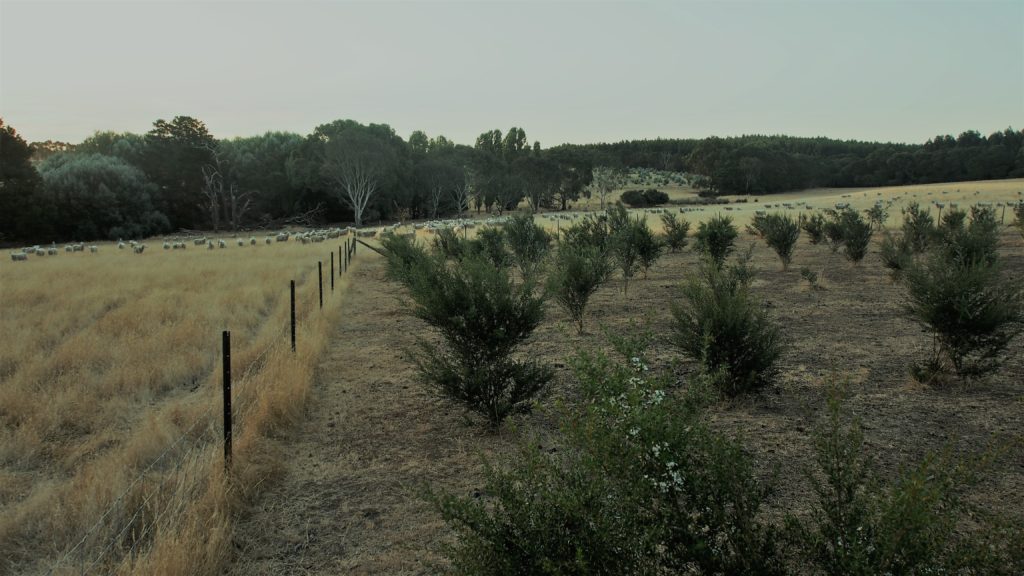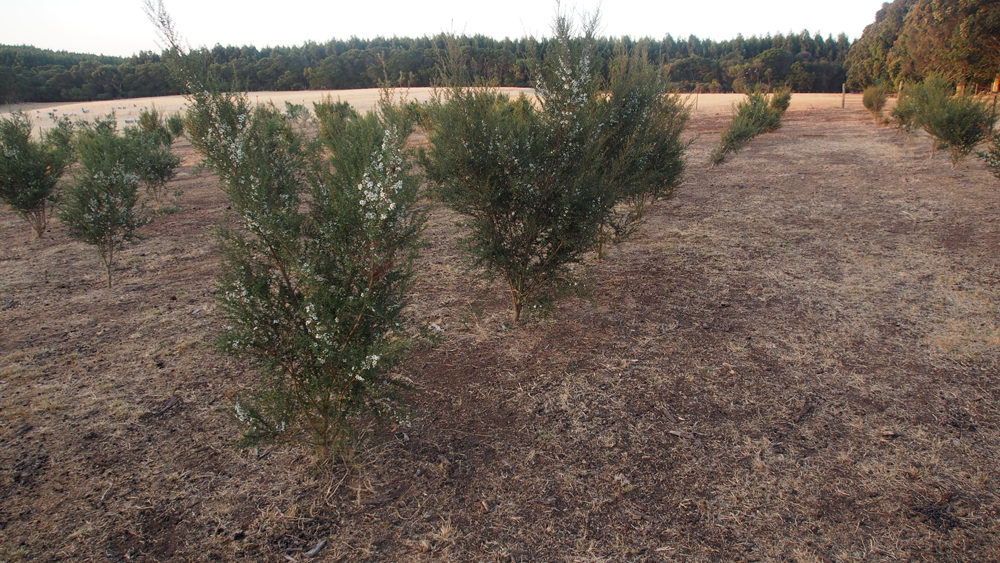
The Leptospermum scoparium plants in this picture are growing in SW Victoria under rainfed conditions and are 17 months of age as of January 2018. These plants were grown from selected seed sourced from inland areas in the Grampians region. Note that full flowering time is from December through to January in any given year. This is consistent with the full flowering time in the wild.
There may be however sporadic and light flowering elsewhere throughout the year. This may lead to some confusion with some casual observers of when the actual full flowering period is.
This fenced enclosure was intended to exclude the sheep and prevent them from browsing the plants. So here was a ‘Eureka’ moment when I discovered someone had left the gate open and the sheep got in for an extended period. To my amazement, the sheep had eaten every blade of grass and every weed and did not touch any of the Leptospermum plants at all.
They ventured out to the main paddock, where the grass was abundant, then ventured back at night to camp in the sheltered environment in the plantation. The ground by this stage was carpeted with sheep droppings thus illustrating another beneficial upside.

In summary then, once these plants are 2 years old, sheep can be run alongside the Leptospermum scoparium with mutually beneficial results. This is exciting stuff, which one always hoped would be possible, which now has now exceeded expectations.
Let’s define integrated farming as a system with two (or more) complementary income-producing primary production activities occurring on the same unit of land, and where one of these activities compliments in some way the other or better, still each other.
One traditional integrated farming activity has been (and still is) farm forestry where tree planting in avenues or shelterbelts provides long-term income from timber but at the same time offers shade and shelter for stock and protection from the wind for crops as well salinity interception in some cases.
While farm forestry is the apparent activity when thinking of integrated farming, but it doesn’t end there by any means.
5 to 10m wide-spaced hedgerows of Leptospermum growing 2 or 3 metres in height and of upright habit make for a range of complementary opportunities.
Sheep are an obvious one as they don’t eat the plants and will benefit from the shade and shelter provided along the hedgerows. Any loss of carrying capacity arising from the presence of these hedgerows (if any) is more than offset by the shade and shelter provided not only for the livestock but for any improved pasture established or encouraged to grow in between the rows.
That is just the beginning. Proper fencing, proper management and the use of Maremma dogs will allow for these areas to be used for farming free-range poultry for example. The birds would also benefit from the protection provided by the hedgerows. Turkeys and possibly some game bird varieties could also find a way into this.
Cropping down the rows could also be another option depending on what part of the country is being considered. Seed-grown annual strip crops could potentially provide a useful pollen source that would be available before the Leptospermum flowering. Considerable caution must be taken due to the widespread use of persistent insecticidal seed coatings that are highly toxic to bees even in minute concentrations and can remain in the immediate environment for long periods of time. One such chemical is Neonicotinoid pesticide.
Cut flowers might also be an option along with vegetables again taking care not to introduce chemical residues to the area. Anything at all provided it does not create any shade along the hedgerows.
Shelter Belts
Multi-row shelter belts using single species Leptospermum is another option worth considering instead of the more conventional mixed-species approach.
This would be approached differently depending on individual circumstances.